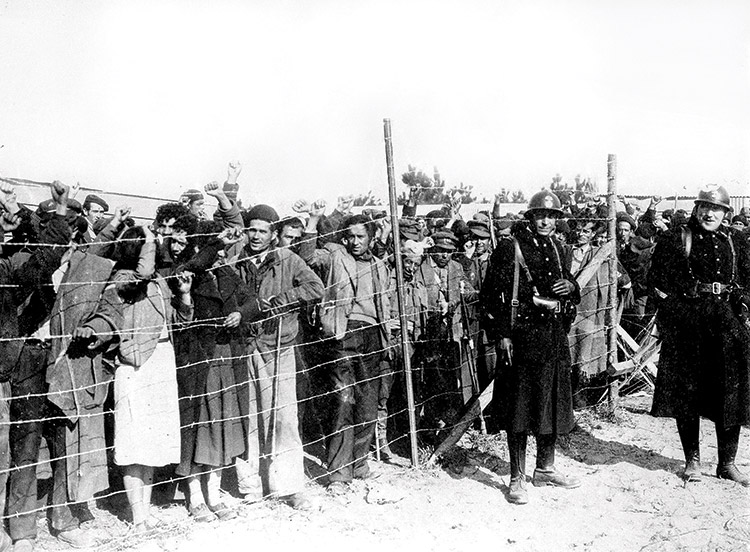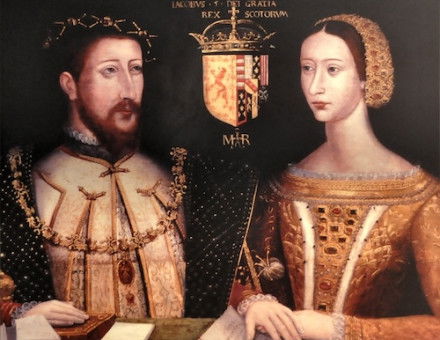Refugees and the Spanish Civil War
Franco’s 1939 victory in the Spanish Civil War saw half a million refugees head north to France. They would be followed by many more in a decade of disaster.

Today’s wave of desperate asylum seekers fleeing the Middle East and North Africa is sometimes seen as a return to the late 1940s, when millions were set adrift by the unprecedented violence of the Second World War. Yet the opening chapter in this age of refugees came not in 1945 but in 1939, with the exodus of Spaniards fleeing the newly installed regime of Francisco Franco.
La Retirada, the retreat of Spaniards at the conclusion of the three-year-long Spanish Civil War, purged the country of half a million republican sympathisers. But, if their flight was unlamented in Spain, they were no more welcome in France. The icy reception by the government of France would be swiftly followed by the callous treatment of other anti-fascists: Germans, Austrians, Poles, Hungarians and Jews, among others.
By late October 1938 the elected republican government of Spain was in dire straits. The government had just 17,000 rifles to defend Catalonia, the last bastion of the Republic. When Barcelona fell on January 23rd, 1939, hundreds of thousands of soldiers and civilians, fearing Franco’s wrath, fled as quickly as their exhausted limbs could move them to the French border.
As they made the perilous trek over the Pyrenees, the Spaniards might have hoped that after three years of war they had survived the worst. They were disappointed. If war was hell, exile in France was hell in a colder climate.
Under the Popular Front government, which came to power in 1936, France had officially acted as neutral, but stood in unofficial solidarity with the government in Spain. But in June 1937 the administration of socialist Léon Blum fell to conservative demonstrations, terror and intrigue and the incoming Radical government, with Édouard Daladier at the helm, regarded the Spaniards as dangerous reds who threatened to destabilise an already politically fragile country.
Ill-prepared for a mass influx of refugees and preoccupied with an unpredictable Adolf Hitler, the French government forced hundreds of thousands of Spaniards into squalid camps scattered across southern France. The exiles were interned in 15 improvised sites, some just barbed-wire enclosures laid out over Mediterranean beaches, lacking shelter and sanitary or cooking facilities. In the first six dismal months, 14,672 refugees in these ‘reception centres’ died from malnutrition or dysentery.
***
One of the most notorious of the camps that served as a makeshift holding pen was the Camp de Rivesaltes, which clung to a windswept semi-desert near Perpignan. Built in 1938 to acclimatise troops to arid conditions, the camp was hastily reconfigured to take in Spanish refugees. For the 8,000 men, women and children in it, Rivesaltes was only a slight improvement on the exposed beaches of the camps at Saint-Cyprien, Argelès-sur-Mer and Le Barcarès.
If they lacked adequate food, accommodation and medicine, the refugees there found they had an abundance of another amenity: French guards. ‘We’re up to our ears in gendarmes’, complained one refugee. The supervision was so pervasive and perverse that ‘they spied on us when we had a bowel movement’.
Another exile recalled that the guards ‘treated us like dogs; they robbed us; they beat us; they pushed us around. For them we were just a bunch of undesirables whom they needed to get rid of as soon as possible, but only after, of course, they had bled us dry’.
Little wonder that one of the Spanish artists who graphically captured the exiles’ misery, Josep Bartoli, portrayed French guards as morbidly obese martinets in fancy uniforms supervising stick figures of half-dressed inmates.
Taunted and ill-treated, the refugees understood that the object was to force them back to Spain. In despair, some complied. On return they were greeted at the border by the Guardia Civil, then sent to prison or, in some cases, executed. By December 1939, just under 200,000 Spaniards and others who fought in Spain remained in France.
If Rivesaltes could be generously labelled a ‘reception camp’ – one of several euphemisms used to disguise their true function of internment – another notorious prison at Vernet deserved the description assigned it by writer Arthur Koestler: ‘the worst in France’.
Initially, the Vernet camp, some 50 kilometres from Spain, was used to detain the most militant of the foreign combatants who had fought in the International Brigades, including members of the anarchist Durruti Division and communists from Germany and Austria.
Six months later they were joined by another wave of anti-fascists. When Germany declared war on September 1st, 1939, France turned sour on another group of the three million exiles living in its midst. Over the previous six years these outcasts had fled Nazi Germany, Fascist Italy and the authoritarian regimes of Eastern Europe and the Balkans.
Arthur Koestler was one of them. Born in Hungary, Koestler had been a member of the Communist Party of Germany from 1931 to 1938, before leaving it in disgust on hearing of Stalin’s Moscow show trials. During the grim summer of 1939, as Europe hung on tenterhooks over who might be Hitler’s next victim, Koestler was lying low in southern France. He was supposed to be writing what would become the best-selling anti-communist novel, Darkness at Noon. But it was hard to keep his mind on fiction. Any sense of calm, he wrote later in his memoir The Scum of the Earth, was drowned by ‘a tide of xenophobia [sweeping] over France with morbid rapidity’.
As one of the hated foreigners with dubious political sentiments, Koestler was arrested a month after the war began and interned at the Vernet camp. At the time, he thought the conditions were ‘even below the level of Nazi concentration camps’, though 30 of the men in his barrack could make the comparison with greater authority: they had all suffered periods of imprisonment at Dachau, Oranienburg and Wolfsbüttel.
‘If somebody screamed at night in our barrack, we knew he had dreamt of the Gestapo. And, regaining consciousness, he recognized with relief the smell of the rotting straw of Vernet’, Koestler caustically observed.
One hut at the camp, nicknamed the Leper Barrack, was made up of 350 veterans from Spain. They were ‘remnants of the International Brigades – once the pride of the European revolutionary movement, the vanguard of the Left’. Koestler recalled that ‘even the most wretched in the other hutments looked upon these with a mixture of horror and dismay’. None of them ‘possessed a change of shirt or socks, and [they] went about naked under a thin and ragged jacket. The barrack was infested with vermin and disease.’
Compared with these ravaged souls, even with internees in his own barrack, Koestler was fortunate. Influential friends in England put pressure on the French government and after three months at Vernet he was released. Koestler was one of the last to reach freedom. As he related a week after France capitulated to Germany on June 22nd, 1940, the Gestapo made its first visit to the Vernet camp. ‘What a find for Himmler’s black-clothed men! Three hundred thousand pounds of democratic flesh, all labelled, alive, and only slightly damaged.’
***
The French defeat further swelled the concentration camps, with political opponents now being joined by those deemed to be untermenschen. In 1942 Marshal Philippe Pétain, collaborationist head of the Vichy government, began to co-operate with the Nazi regime’s campaign of mass extermination. Jews, Roma, political dissidents and Spanish Republicans were transferred from French internment to the concentration camps of Germany, Austria and Poland, where they were forced into slavery, then slaughtered. Almost 5,000 Spanish Civil War veterans were killed at the Mauthausen concentration camp in Austria.
Some Spaniards were able to leave the camps in France under extraordinary circumstances, by, for example, agreeing to volunteer for the French Foreign Legion in North Africa. There, they later joined up with Allied units to help fight the Axis forces.
Other Spaniards returned to the anti-fascist struggle via another route. In late 1939, given the alternative of continued internment or deployment in semi-militarised work brigades, about 60,000 opted to aid the French military. Most were assigned to help strengthen the Maginot Line in north-east France. When the Phony War ended in May 1940 with a massive German offensive, Spanish Republicans from the work units took up the first acts of sabotage against the occupiers. Their Spanish comrades in Vichy France, skilled in guerrilla war from the campaign against Franco, escaped imprisonment and helped to form maquis units in south-western France.
Resistance in the camps also took on artistic forms. The Catalan artist Josep Franch Clapers had fought against Franco in 1936. But along with hundreds of thousands of comrades he found himself in French ‘sojourn camps’ in 1939. Throughout the year he spent in two camps he sketched and painted hundreds of images to document the inhuman conditions imposed on the Spaniards. After the war, a show of his work was mounted in Paris.
The defeat of fascism in 1945 allowed millions of displaced people to make their way home. The Spanish Civil War refugees, however, could not do so. Their country would remain in the grip of Franco until his death in 1975. Of the 500,000 Spanish refugees in France in 1939, 160,000 remained in 1962.
At least they were no longer in camps. Ironically, the space was needed for refugees from France’s failed war to keep Algeria in its empire. When the eight-year war of independence ended in 1962, over 90,000 Harkis – Algerians who had fought with the French military against the Algerian National Liberation Front – sought refuge in France. Astonishingly, the camp at Rivesaltes was pressed into service and between 1962 and 1964 some 20,000 former soldiers and their dependents were kept in conditions every bit as primitive as those of two decades before.
Although France encouraged Algerians to remain loyal to it, when the war was lost the government had no plan to accommodate the Harkis in the metropolis. For years, it did not recognise any right for them to stay in France as residents and citizens. An apology of sorts was offered to the Harkis in 2012, when President Nicolas Sarkozy recognised France’s ‘historical responsibility’ in abandoning and interning Harki Algerian veterans.
Spaniards who were interned, even those who fought for France in the Second World War, are still waiting for a word of acknowledgement of the sacrifices they made. The writer Jorge Semprún, a Spanish refugee, had joined the French Resistance and was captured by the Germans in 1943, surviving for two years in Buchenwald concentration camp. In the closing weeks of the war he and other prisoners had armed themselves and helped to defeat SS units controlling the camp. After VE Day, waiting for a repatriation bonus in a Free French government queue, he was denied and told simply: ‘You’re not French.’
Larry Hannant is Adjunct Associate Professor in the Department of History at the University of Victoria, British Columbia.




